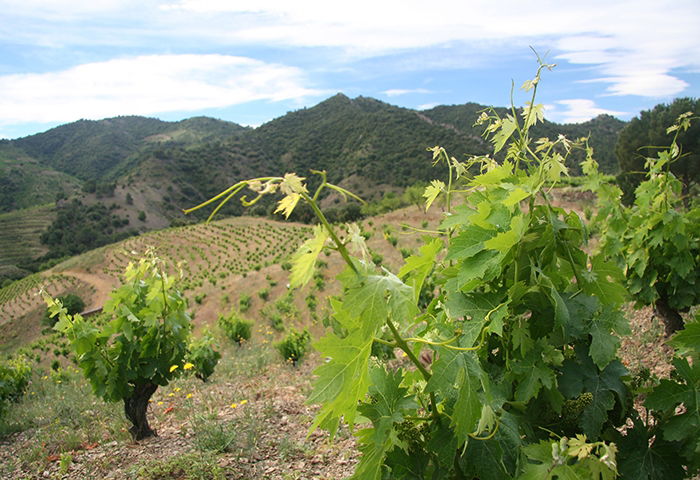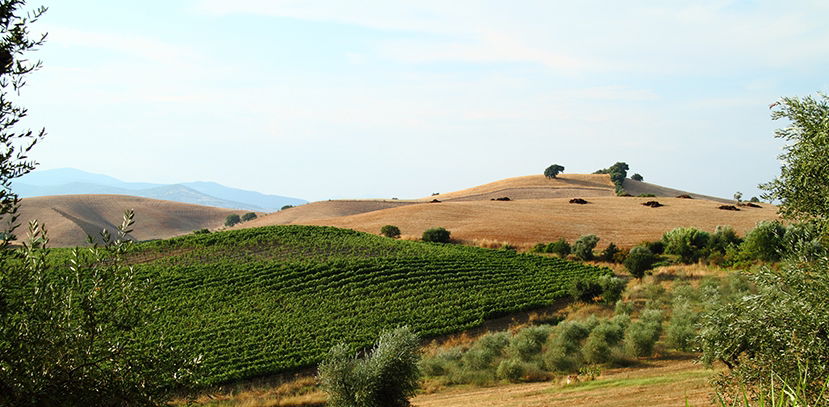BLOG
Priorat, The Wine of Life
Elizabeth Hecker Regional Spotlight

Prioratans have a saying: Si ets calatà, de les pedres treuràs pa. Pero si ets a Priorati, treuràs vi. It means “The Catalan people make bread from stones, but the Prioratans make wine.” Their llicorella rock soils provide the kind of struggle that produces some of the most sought-after wines in the world. Enclosed within the Montsant Mountains, two hours from Barcelona, the Priorat is a tiny wine region whose fame is overshadowed only by the powerful beauty of its landscape.
Take a sip of a Priorat wine and give way to your senses. Embark on a journey to a mountainous landscape. The sun is setting and everything is glowing. An old man emerges from the vines, holding grapes in his hand. A church bell rings in the distance. You sense the generations who were part of this land long before the outside world discovered it.

Each vineyard and variety has its own time. Years of experience help winemakers decide each vineyard’s readiness based on the wines they envision. © E. Hecker, 2022
The Priorat gained notoriety at the beginning of the new millennium with deep, rich, powerful wines so popular at the time. The strength of character they expressed reflected the spirit of the people. Today, some winemakers are seeking more openness in their wines, picking earlier and using less heavy extractions. Nevertheless, the distinctive character of the Priorat terroir leaves its imprint. At first, Priorat white wines were not well known, but now they are equally respected, displaying finesse or freshness as the winemaker chooses to make them.
Perhaps the most lauded element of the Priorat terroir is its “soil,” known locally as llicorella. Geologically, the majority is slate metamorphosed from the Carboniferous Period hundreds of millions of years ago. But the oldest llicorella was formed in the Devonian Period, of calcareous origin. Its foliation suggests it is actually schist. Other rocks in the Priorat which are also considered llicorella are hornfel, quartzite and black slate. Together, llicorella rocks constitute about 80% of the Priorat’s soils. The rest are composed of sedimentary rocks, sand and clay, and igneous rocks. Humidity from the sea and any precipitation gathers deep in the earth, forcing the vines to send their roots through crevices to find nourishment. Deep roots give the vines resilience in even the driest years.

People are often confused by what is known as “soil” in the Priorat. Metamorphosed rock (mostly slate) from the Carboniferous Period is locally called llicorella. © E. Hecker, 2022
The mountainous topography varies in altitude from 164 feet (50 meters) to 3675 feet (1120 meters), with steep slopes known as costers. The Mediterranean Sea sends cooling breezes to moderate the continental heat. They flow through the mountains and valleys, creating a multitude of microclimates. Bud break and grape maturation can vary by as much as a month depending on location and orientation. An extensive biodiversity lends its healthy energy to the viticultural habitat.
Priorat wines are a journey into the earth, collecting echoes of history along the way. The people of the region were growing grapes even before the Carthusian monks arrived in the 12th century. The vines and the people who care for them share a story of survival and the will to drink deeply of life. They live in a syncopated rhythm season to season, generation after generation.

Words recorded on the walls of Celler Cal Pla date back to 1814: Observe al vi lo bon tastado, son gust, aroma forsa y color. It means “See the wine with good taste, strong body and color.” © E. Hecker, 2022
Winter is a gift. People need time to rest, just as the plants and animals do. The people bundle up and head into the vineyards with a thermos of hot coffee and some bread, cheese and jamón. This is the time to make the poda, to prune, and reconnect with each vine. Their movements are intentional but without urgency. The leafless and vulnerable vines entrust themselves to the care of their people. Each snip of the shears is a recollection of the past and a look to the future.
When it seems the stillness will never end, winter melts into the awakening of spring. The landscape sparkles as if lit from within. Furry buds push out of what appears to be dead wood. Soon youthful new shoots fly out in every direction. The people, equally enthusiastic about the sunshine, plant new rootstock and graft those established the year before. And the mules are happy because they are able to get to work tilling the earth. As the season progresses, delicate flowers become baby clusters of immature green grapes.
Perhaps it is the sultry heat that makes the summer so languid. The sun shimmers across the llicorella-clad costers as if the Priorat is merely a mirage. The vines have stopped growing, directing all their energy to ripening the fruit. The people wander through the vineyards, letting nature reveal what it needs to ensure the success of the harvest. The old vines are firmly rooted to their place and know exactly what to do. Younger vines may need thinning for a more balanced crop. Eventually, the grapes begin to take on wine-like hues, building the anticipation. As the summer comes to an end, the grapes are nearing their point of perfection.
Autumn brings a chill to the air and the vistas shift from verdant green to a blaze of glory. Carinyena leaves become a fiery red and Garnatxa turns to shades of gold as the vines focus their energy inward in preparation for their awakening the following spring. When the time for harvest arrives, everyone is up before the sun, shears in hand, crates waiting. In the Priorat no mountain is high enough, no valley low enough, no llicorella slope steep enough to keep a grower from collecting the fruits of the vintage’s labor. No matter how treacherous, it must be done with agility and speed.

Before the invention of the engine, mules carried the grapes to the cellars one load at a time. Today, a trusty, often rusty, truck is used to deliver the precious fruit more swiftly. © E. Hecker, 2022
At the cellar the grapes are promptly refrigerated until it is their turn to be sorted. With production so small, sorting is crucial. Only the most luscious are allowed to pass, as whole clusters or loose berries. The process of becoming wine begins with maceration, by foot or paddle, gently breaking the skins to introduce oxygen and initiate the conversion of sugars to alcohol. This is fermentation, alchemy, when the grape juice becomes something more precious: wine. The individual grapes are now part of a greater whole, a collective expression of the vintage.
The autochthonous varieties of the Priorat are Garnatxa Negra and Blanca and Carinyena. The challenges of the terroir moderate their otherwise vigorous growth. The red varieties can be elaborated individually, blended together or blended with other reds like Syrah to become beautiful expressions of life in the Priorat. Garnatxa is the pretty one, the Pinot Noir of the Priorat, dancing across the palate with beguiling charm. Carinyena is powerful, if not a little wild, tamed to penetrating perfection with its innate structure. Garnatxa Blanca, when blended with other Priorat white varieties like Macabeu or Pedro Ximénez, produces wines bright and fresh or smooth and silky with tannins so sweet they can be mistaken for those of a Priorat red.

The voice of nature is speaking through the vines, in the language of the senses, and finds itself in a Priorat wine. It is an expression of the terroir and the human spirit that formed it. © E. Hecker 2022
Wine is an expression of both the terroir and the human spirit that formed it. Taking time to understand the relationship between the region a wine comes from and what we sense reveals an inner world where humanity and the natural world meet. The voice of nature is speaking through the vines, in the language of the senses.
Lift your glass, close your eyes and breathe deeply. Search for the impressions of a region with a viticultural heritage as deep as the roots of the old vines. Discover the expression of confidence of vines which have spent a century adapting to their place. Or frolic with the vivacious fruit that speaks of excitable young vines. Ponder the biodiversity that gives dimension to sense of place. Explore the minerality of rocks too strong to be broken down by time. Seek depths reminiscent of hot summer days or the freshness of cooling fog from the sea. The Priorat is no longer an anonymous wine poured from a bottle that came from a store. You know this wine now, and will remember it forever.
 Ethos Priorat: Listen, the Wine Is Talking.
Ethos Priorat: Listen, the Wine Is Talking.
This story is based on Ethos Priorat, a coffee table book that is both a definitive resource about the terroir and history of the region and a visceral journey into the life inside the wines. If you listen, the wine is talking…
Your copy of Ethos Priorat is currently available for pre-order! Click here to visit Académie de Vin Library to pre-order the book. Don't forget that WSG members always receive 10% off all books on at Académie du Vin Library. Become a WSG member today and benefit from the discount on other fantastic wine books from their collection.
What are people saying about Ethos Priorat:
‘Elizabeth Hecker’s book is a beautiful and passionate portrait of Priorat and of those who live and work there. We see with her eyes through her haunting, honest photographs. We hear the voices she has heard, the stories she has been told. We learn something of the history of this place over the centuries of human habitation, and the millennia during which its stones and slopes came into being.’
— Andrew Jefford, Wine Writer and Educator
‘Despite the physical beauty of the book, and the compelling stories that the photos tell, this is not a coffee-table book. It is detailed, practical, packed with facts from years of research and walking the vineyards and villages. Ethos Priorat is, quite frankly, a work of art. Hecker’s years of experience culminate in a book that you want to breathe in, slowly, meditatively, deeply. Her immersion in Priorat saturates every page. It’s a paean to a region without obeisance or cliché. It’s a prayer. It’s timeless.’
— Tamlyn Currin, JancisRobinson.com
‘Elizabeth’s prose is charming, sometimes earnest, grounded in facts and contexts, and when she’s writing about families, full of love. The book as a whole is a considerable achievement.’
— Terry Theise, Wine Writer and Importer
'Ethos Priorat is a stunning visual journey through one of Spain’s most significant wine regions. It introduces not only a necessary understanding of the Priorat but, more importantly, a look at the people who have dedicated their lives to the soil, vine, and amazing wines produced here. This book deserves a place amongst the best books on wine.’
— Rick Fisher, Spanish Programs Director, Wine Scholar Guild



